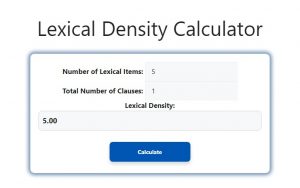About Lexical Density Calculator (Formula)
Lexical density is a vital concept in linguistics that measures the amount of meaningful content in a piece of writing relative to its total length. It provides insights into the complexity and informativeness of text, allowing writers to assess their writing style. By calculating lexical density, one can determine whether their writing is succinct and rich in content or overly simplistic. The Lexical Density Calculator is a handy tool for students, educators, and professionals who want to enhance their writing by understanding the balance between content and function words.
Formula
The formula for calculating lexical density is:
Lexical Density (LD) = (Number of Lexical Items / Total Number of Clauses)
Where:
- LD = Lexical Density (expressed as a percentage)
- Number of Lexical Items = Count of content words such as nouns, verbs, adjectives, and adverbs.
- Total Number of Clauses = Total count of clauses in the text.
How to Use
Using the Lexical Density Calculator is straightforward and involves a few key steps:
- Prepare Your Text: Select the piece of writing you want to analyze. This could be anything from an essay to a business report.
- Count Lexical Items: Identify and count the lexical items (content words) in your text. Focus on the nouns, verbs, adjectives, and adverbs while excluding function words such as prepositions, conjunctions, and articles.
- Count Total Clauses: Determine the total number of clauses in your text. A clause is a group of words that contains both a subject and a verb, forming a complete thought.
- Input Values into the Formula: Use the counts from steps 2 and 3 in the lexical density formula.
- Analyze Your Result: Review the lexical density percentage to understand your writing style. A higher percentage indicates a denser, more informative text, while a lower percentage suggests a more conversational or simplistic style.
Example
Consider the following example to demonstrate the use of the Lexical Density Calculator:
“The cat sat on the mat.”
- Number of Lexical Items: 5 (cat, sat, mat)
- Total Number of Clauses: 1 (the sentence contains one clause)
Using the formula:
LD = (Number of Lexical Items / Total Number of Clauses)
LD = (5 / 1) = 5
In this case, the lexical density is 5, indicating a very concise text with a good amount of information conveyed.

FAQs
- What are lexical items?
Lexical items are content words that carry meaning, including nouns, verbs, adjectives, and adverbs. - What is a clause?
A clause is a group of words containing a subject and a verb, forming part of a sentence. - Why is lexical density important?
Lexical density helps evaluate the complexity and informativeness of writing, affecting readability and comprehension. - How can I improve my lexical density?
To improve lexical density, use more content words and reduce filler or function words in your writing. - What is a good lexical density percentage?
A lexical density of 40% to 60% is often considered effective for clear and informative writing. - Can lexical density be too high?
Yes, excessively high lexical density can lead to dense and difficult-to-read texts. - Is lexical density the same as readability?
No, they are different concepts. Readability assesses how easy a text is to read, while lexical density measures the proportion of meaningful words. - How can I identify lexical items in a text?
Focus on nouns, verbs, adjectives, and adverbs while ignoring function words. - Can I analyze any text with this calculator?
Yes, the calculator can be used for any type of writing, from academic essays to emails. - What are some practical applications of lexical density analysis?
It can be used in education, editing, content creation, and research to evaluate and improve writing quality. - Does lexical density vary across different writing styles?
Yes, different genres and contexts can lead to varying lexical densities; academic writing typically has higher densities than conversational writing. - How often should I analyze my writing for lexical density?
Regular analysis can help you track improvements and adjust your writing style. - What should I do if my lexical density is too low?
Revise your text to include more content words and reduce filler phrases. - Can lexical density impact academic performance?
Yes, students with higher lexical density in their writing may perform better in assessments that require clarity and depth of information. - What tools are available for calculating lexical density?
There are various online calculators, software, and linguistic analysis tools that can help. - Is there a difference in lexical density between spoken and written language?
Yes, written language typically has a higher lexical density than spoken language, which is often more informal. - Where can I find more resources on lexical density?
Look for academic journals, writing guides, and educational websites focused on communication skills. - Can lexical density affect audience engagement?
Yes, a balanced lexical density can enhance audience engagement by making writing more accessible and informative. - How does lexical density relate to academic writing?
Higher lexical density is often expected in academic writing, as it demonstrates a greater depth of knowledge and analysis. - What are common mistakes when calculating lexical density?
Common mistakes include miscounting lexical items or clauses and failing to differentiate between content and function words.
Conclusion
The Lexical Density Calculator is a valuable tool for anyone looking to enhance their writing skills. By understanding and calculating lexical density, writers can refine their style and improve the clarity and effectiveness of their communication. Whether for academic, professional, or personal writing, mastering lexical density can lead to better engagement and comprehension from the audience.